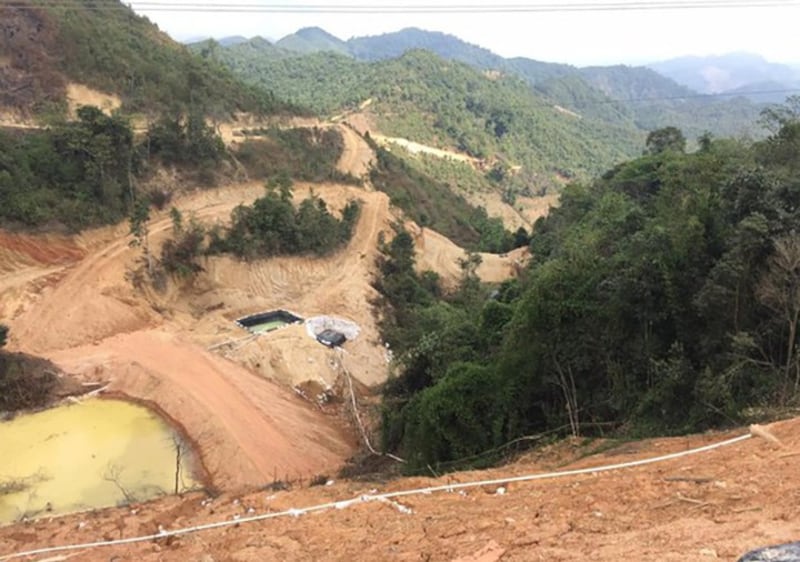Water polluted by a Chinese-backed rare earth mining operation in northeastern Laos is now safe to use and company representatives have agreed to meet with affected residents to discuss compensation, according to officials.
Clean-up of the site in Houaphanh province marks a rare win for villagers in Laos, where officials typically exercise little oversight of foreign companies that exploit the country’s natural resources, with little regard for the impact on the environment and local communities.
Rare earth minerals are important in the production of high-end technology such as cell phones, computers, and satellite and aerospace technology, with much of the international trade in the minerals controlled by China.
On Feb. 22, a mining operation in Houaphanh’s Xam Neua district run by Laos-China Rare Mineral Development Company North 2 Ltd. discharged polluted water into two area rivers, causing a large fish kill and damaging the ecosystem in 36 villages.
Tests in early March showed that the water from the Van and Xam Rivers contained cyanide, zinc, copper and iron, and was high in acidity. On March 4, villagers wrote a letter calling on the People’s Council of Houaphanh Province to deal with the pollution as soon as possible.
‘Safe and good’
Last week – more than two months after the incident – district, provincial, and central government officials and company representatives met with affected villagers to “guarantee” that the river water is now “safe and good for growing rice,” said a Xam Neua official who, like others interviewed for this report, declined to be named because he was not authorized to speak with the media.
“In addition, [environmental] officials also collected water from four or five more spots to test it again to make sure that the water is really safe,” he told RFA Lao.
Laos-China Rare Mineral Development Company North 2 Ltd. vowed to prevent another discharge of chemicals at last week’s meeting, the official said, adding that it would “shut down for good” in the event of a similar incident.
“With regard to damage, the company is asking the affected villagers to gather information about the pollution’s impact on their property and company representatives will meet with the villagers on May 20 to discuss compensation,” he said.
Another Xam Neua official, who also spoke on condition of anonymity, said he was “relieved” by the company’s assurances.
“Now our farmers will be able to work on their farms again,” he said. “In the future, if the villagers are impacted again by pollution, the company will be held responsible for the impact and compensation.”

The second official said a third round of testing is being conducted to confirm that water in the two rivers is safe.
“The villagers feel relieved because nobody would talk to them before, but now they [officials and the company] have met with them and given them some assurances,” he said.
Rare earth mining
Foreign-invested farming, mining and development projects in Laos have sparked friction over cases of environmental pollution and land often taken without proper compensation, leaving villagers fearing retaliation if they speak out.
But villagers from Xam Neua told RFA they are glad Laos-China Rare Mineral Development Company North 2 Ltd. is taking responsibility for polluting the water supply.
“The problem has been solved and the company said it’s going to take care of any damage and compensation,” said one resident. “As for the water, it’s getting better. I haven’t found any dead fish in the last week or so.”
A second resident said that the company was doing the right thing by admitting its mistakes and making the community whole.
“Any villagers who suffered damage caused by the pollution will be compensated,” he said. “For example, they’ll be compensated for their polluted vegetable gardens and their sick or dead livestock.”
A third resident said that while it is a bit late to begin planting rice, “it’s better than nothing.”
Other villagers remained skeptical about the condition of the water in the Van and Xam Rivers.
“I’m not quite convinced that the water is 100% safe and that the company will be responsible for all damages and impact,” one told RFA. “I’m still worried about the long-term impact.”
But Khamso Kouphokham, Deputy Director General of Department of Energy Policy and Planning at the Ministry of Energy and Mines, said that authorities had ordered the company in question to suspend its operations until inspections and testing were complete.
A third round of water testing was scheduled for Monday, officials said.
Other mining incidents
Laos-China Rare Mineral Development Company North 2 Ltd. operates facilities in Houamuang district’s Outhai village and in Xam Neua district’s Sobxay and Thabpheung villages. The company has invested US$41 million to develop a 500-hectare (1,235-acre) mining concession.
Other Chinese-backed rare earth mining operations in Laos have been less well-received by residents following recent incidents of environmental damage and land disputes.
Last month, a tanker truck carrying sulfuric acid from northwestern Laos to a Chinese rare earth mining company flipped over near the seat of Luang Prabang province, spilling its contents into a tributary of two major rivers and devastating the local ecosystem. Local officials barred residents from drinking and bathing in the water and said they are testing it to determine how to proceed.
In 2022, Lao government officials cleared China’s Tong Lee Seung Industrial Development Company to dig for rare earths on farm and grazing land in Xieng Khouang province’s Phaxay district. Much of the land was already in use for farming and grazing cattle, prompting a dispute over compensation.
China is Laos’ largest foreign investor and aid provider, and its second-largest trading partner after Thailand.
Translated by RFA Lao. Edited by Joshua Lipes and Malcolm Foster.
